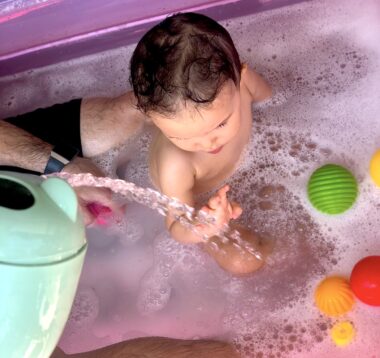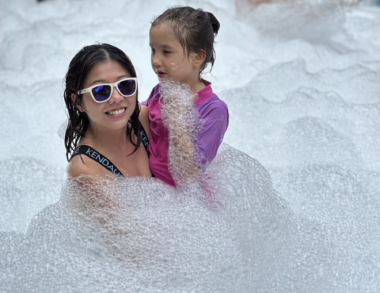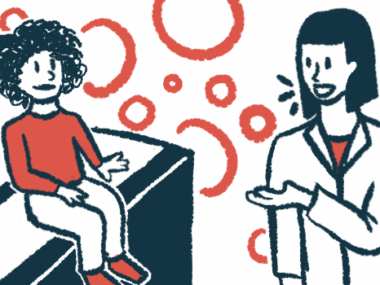From bath-time tears to foam party cheers, thanks to bubbles
How a simple tool led to an unforgettable celebration
Written by |

When our daughter, Rylae-Ann, was born with aromatic l-amino acid decarboxylase (AADC) deficiency, we were handed a long list of symptoms that felt more like a set of instructions on what she couldn’t do. It was devastating.

Bubble baths were a fun bonding time for Rylae-Ann and her dad and an opportunity for sensory integration. (Courtesy of Richard E. Poulin III)
For a moment, my wife, Judy, and I thought our dreams for her were over. But then we decided: No diagnosis would stop us from living a life full of love, laughter, and unforgettable moments — even if that meant starting small with bubbles.
By 3 months old, it was clear that Rylae-Ann wasn’t hitting milestones. As her condition became clearer, we adapted everything, including bath time. The first time we lowered her into the tub, her cries could have shattered glass. Every splash felt like a betrayal — but then came the bubbles.
Bubbles turned bath time into a giggle-fest. When I made a Santa beard with foam, she snorted and giggled. When Judy helped her pop bubbles, her eyes lit up with wonder.
What had started as a desperate distraction became a routine that helped her manage emotions and develop sensory integration skills, and it gave us some of our first shared laughs. Bath time became less of a battlefield and more of a bonding time.
Speech therapy in disguise
At 18 months, Rylae-Ann underwent experimental gene therapy, and everything began to change. Her anxiety lessened, milestones we thought we’d never see started appearing, and bath time became just plain fun. But we didn’t ditch the bubbles; we doubled down.
Judy, a special education teacher, knew bubbles weren’t just for play; they were perfect for speech therapy! Blowing bubbles helped Rylae-Ann strengthen her lips, learn breath control, and build muscles for making sounds. We upped the fun factor with silly sound effects and songs. It turns out nothing motivates a child to work on oral motor skills like the promise of bubbles floating through the air.
A bubble celebration
Fast forward five years, and bubbles are still a big part of our lives. From bubble guns to bath bombs, they’re everywhere. But this year, we upped our game and took Rylae-Ann to her first foam party at a hotel to celebrate the fifth anniversary of her gene therapy, a day we call her “Reborn Day.”

Judy and Rylae-Ann pause from dancing at a foam party to take a picture. (Photo by Richard E. Poulin III)
Music played, and waiters made their way along the poolside, serving drinks and food. Every hour, there was a fun event or activity. Rylae-Ann especially enjoyed jumping in the inflatable hamster ball and running across the water.
The best part was the foam party at the end. Foam filled the dance floor and continued to be pumped out as everyone danced. Judy and Rylae-Ann twirled nonstop as I tried to snap pictures to capture the moment. At times, we worried we would lose Rylae-Ann among all the bubbles, but there was no mistaking her infectious laughter.
A journey worth every bubble
Six years ago, we couldn’t have imagined the journey bubbles would take us on. They started as a tool to calm bath-time tears and became an unforgettable celebration of how far Rylae-Ann has come. Whether it’s bath time or a foam party, bubbles remind us that life’s best moments often start small — just like our daughter’s giggle the first time she popped one.
Don’t underestimate the power of bubbles. They can be more than just a game; they can help build skills, create joy, and, if you’re lucky, lead to a fantastic foam dance party.
Note: AADC News is strictly a news and information website about the disease. It does not provide medical advice, diagnosis, or treatment. This content is not intended to be a substitute for professional medical advice, diagnosis, or treatment. Always seek the advice of your physician or other qualified health provider with any questions you may have regarding a medical condition. Never disregard professional medical advice or delay in seeking it because of something you have read on this website. The opinions expressed in this column are not those of AADC News or its parent company, Bionews, and are intended to spark discussion about issues pertaining to aromatic l-amino acid decarboxylase deficiency.






Leave a comment
Fill in the required fields to post. Your email address will not be published.